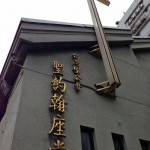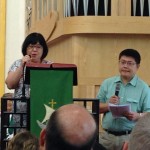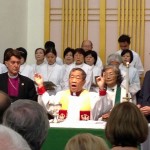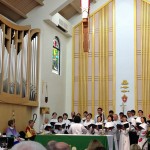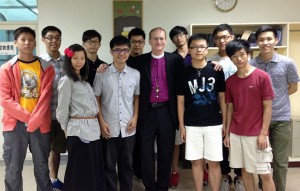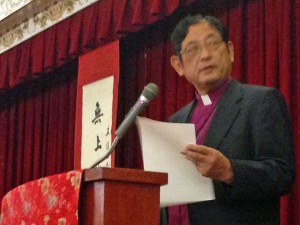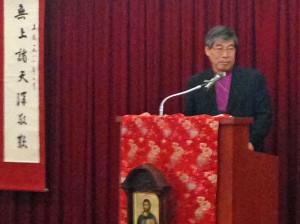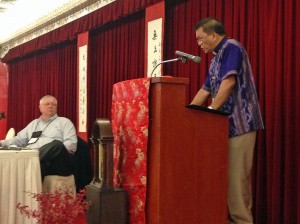I am never going to get caught up unless I compress the last three days in Taiwan into a single post, so here goes.
Sunday
Saint John’s Cathedral is a beautiful, vibrant place, grey on the outside, but filled with light, color, and joy within. We are blessed by what is, I believe, the warmest welcome I have ever received outside of Pittsburgh.
The liturgy is in Mandarin and English, and the place is packed. Saint John’s repeats a familiar profile: a dedicated congregation with a thriving kindergarten, reaching out beyond their walls, blessing their neighborhood and their diocese.
The welcome comes from the senior warden, who greets us in English, while another member of the Vestry translates into perfect Spanish for the benefit of our Latino bishops.
The PB preaches and David Lai celebrates with his customary enthusiasm and reverence.
And the choir rocks us with a bluesy spiritual: so we have just about everything– Book of Common Prayer liturgy, worship and greeting in three languages, Wesleyan hymns, Chinese songs, and a spiritual sung by a Taiwanese chorus. Is this heaven?
Afterwards, we are treated to an amazing lunch. Check out the soup. It’s called Chrysanthemum Bean Curd: believe me, you never had tofu like this.
While the rest of the bishops head to the hotel, +David and Lily jump into the back of a taxi with me and we head for the Cathedral to meet for a Bible Study. There are twelve young people waiting for me, along with the assisting priest at Saint John’s. These folks are about twenty years old, on average. I hand the video rig off to a young man who somehow manages to handle the camera and participate in the discussion. We take the same approach as before– dividing into three groups to discuss the Parable of the Sower– one for hard ground, one for stones, one for thorns. Three really interesting things emerge.
First, this group is clearly more interested in the problem of temptation than the group at Good Shepherd. Cheating on exams comes up as a piece of hard ground– so temptation to do wrong consumes the foreground and the word of God just bounces off. Second, the stony ground for these young people is the non-Christian environment of their schools– the fact that their friends make fun of their faith or the Bible, joking with them that they should cut off a hand or pluck out their eye to show obedience to Jesus. The thorns tend to be the same as the previous group (schedule, social pressure, desire to succeed), but when I ask the million-dollar questions– where is the fertile ground at the bottom of our hearts, and how does the seed find it and bear fruit– an answer comes that hasn’t arisen before. Well it’s the Holy Spirit that is in our hearts, right? So the Word falls into that, and bears fruit that pushes up through all the thorns and the stones and the hard ground. So we look at John 15 and Romans 5 and 8 and then back to John 1, and what emerges is the wonderful truth: the word which the sower sows is not simply the word about Jesus. The Word is Jesus: the crucified and risen Son who makes His home in us with the Father. He is the one who brings forth fruit in us, fruit that looks like him. The Dean tells me later: “They want you to come back!!” I think, maybe next time with some young people from the Diocese of Pittsburgh??
Monday
The first speaker this morning told us, When I was in university I fell in love with a very beautiful girl, who is now my wife. We began dating, but the better we got to know each other, the more painful became the secret I was hiding from her. Finally, after we had been going out together for one year, I told her: I am a Christian. She looked at me, shocked. ‘So am I,’ she said.
The speaker was Archbishop Nathaniel Uematsu, of the Episcopal Church in Japan, the Nippon Sei Ko Kai. Thus he communicated in a most personal way the position of a Christians who together constitute less than 1% of the population. They not only face the challenges of other native religions, but an additional stigma from their history of silence during the rise of fascism in the years leading up to WWII. They were seen as supportive of the State against the interests of the people.
This contrasts with the story told by the Archbishop of Korea, Paul Kim, for whom a theology of the Church “with and for the people” has been foundational– needless to say, mission is easier with such a reputation.
The clearest example of such a theology, however, was articulated by the Most Reverend Edward Malecdan, Prime Bishop of the Episcopal Church of the Philippines. In the aftermath of Tropical Storm Haiyan, the Episcopal Church immediately moved relief supplies into the hardest-hit areas, in which they did not have a presence; as they did so they discovered the reason that all the housing was so catastrophically erased. The people are tenants, and as such have no right to the land on which they live. So they build houses that are intentionally temporary, strong enough to last a year, perhaps, and certainly not able to withstand the winds of the most powerful storm ever to hit land. So, the Church bought land, divided it into lots, lent people the money at zero interest to buy lots and build stronger homes which they now own. It is common for people to pay the loans off in half the time required.
The afternoon was taken up by a closed session in which three topics were presented, a report from TREC on restructuring the governance and administration of the Episcopal Church, a report from the Task Force on Marriage, and a report from the Joint Nominating Committee for the Presiding Bishop. Bishops have a covenant not to speak publicly about the proceedings of closed sessions. However, I will have more to say on all three of these subjects in due course.
Tuesday
The morning included a Town Hall Session (basically a whole bunch of announcements). I gave an overview of The Bible in the Life of the Church Initiative, and my plan for recording the Bible studies in Uganda, Taiwan, the Philippines and Southwest Pennsylvania. Several bishops came up to me afterwards and expressed interest, so we may have some allies going forward. The morning ended with another closed session.
After lunch, I headed to the Palace Museum, where there was a special exhibition of works by one of the great Masters of the Ming Dynasty, Tang Yin. I have wanted to see the National Palace collection for forty years, since I first took a course in Chines painting in college to fill an elective requirement; my teacher was the great Richard Barnhart, and after two weeks I was hooked. The museum in Taipei includes everything that was in the former Imperial household, the Forbidden City. Just before Beijing fell to the communists, the entire collection was trucked to the coast and put on barges bound for Taiwan. I’ll have more to say, perhaps, about the afternoon: let it be enough at the moment to say that this was definitely worth putting on the bucket list.
The evening was taken up with a magnificent banquet, at which we gave great thanks for our hosts. I did not know what to expect when I came to Taiwan, but I am convinced the Church here has much to teach us. It is hugely encouraging to see what can happen when small congregations believe God will provide and that He has sent them to do His work in the world. I see so much of the same work beginning in Pittsburgh. I believe we can expect a similar harvest if we are as faithful.

